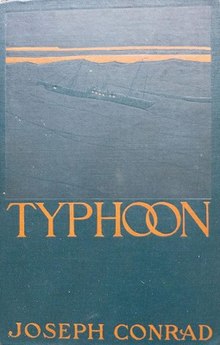|
Typhoon (novella)
Typhoon is a short novel by Joseph Conrad, begun in 1899 and serialized in Pall Mall Magazine in January–March 1902. Its first book publication was in New York by Putnam in 1902; it was also published in Britain in Typhoon and Other Stories by Heinemann in 1903. Plot summaryCaptain MacWhirr sails the Nan-Shan, a British-built steamer running under the Siamese flag, into a typhoon—a mature tropical cyclone of the northwestern part of the Pacific Ocean. Other characters include the young Jukes—most probably an alter ego of Conrad from the time he had sailed under captain John McWhir—and Solomon Rout, the chief engineer. While MacWhirr, who, according to Conrad, "never walked on this Earth"—is emotionally estranged from his family and crew, and though he refuses to consider an alternative course to skirt the typhoon, his indomitable will in the face of a superior natural force elicits grudging admiration. AnalysisConrad "broke new ground" by showing the ways a steam ship differs from a sailing vessel, an historic shift occurring at the time. For example how the crew were broken into "sailors and firemen" [engineers]; the unromantic labors of Hackett and Beal; the captain as a mirror of his ship, isolated from nature and lacking the power of imagination.[1] Stylistically, Conrad made "perhaps the most celebrated ellipsis in modern short fiction".[1] At the end of chapter V the story reaches a climactic point, the ship barely makes it into the eye of the typhoon and faces a final challenge to exit the storm through the eye wall.
This is followed by a single sentence:
The story then leaps forward in time with the ship back in port, the events of what happened unstated. This was an innovative technique with hints of post-modernism.[1] He challenges the reader to fill in the events of the story themselves. The break in the chronology is particularly effective, and jarring, as the preceding passages had been so detailed that the time it took to read the novel and the real time of the story were not so far apart.[1] Real life connectionsIn 1887, Conrad worked as chief mate on the Highland Forest under Captain John McWhir, whom he portrays in the novel as "McWhirr".[2] He drew upon this six months voyage for the novel.[3] Conrad once dictated to biographer and friend Richard Curle a list of ships he served on, and the stories they were connected to—the connections might have been minor (a single character or incident) or major (a complete voyage), Conrad did not indicate. For Typhoon he said it "suggested" the steamer John P. Best which he served on.[4][5] Joseph Conrad dedicated the book to Cunninghame Graham, a fellow writer and Scots radical who was an enthusiastic supporter of Conrad since his earliest publications.[6] Characters
References
External linksWikisource has original text related to this article:
|
||||||||||||||||||
Portal di Ensiklopedia Dunia
